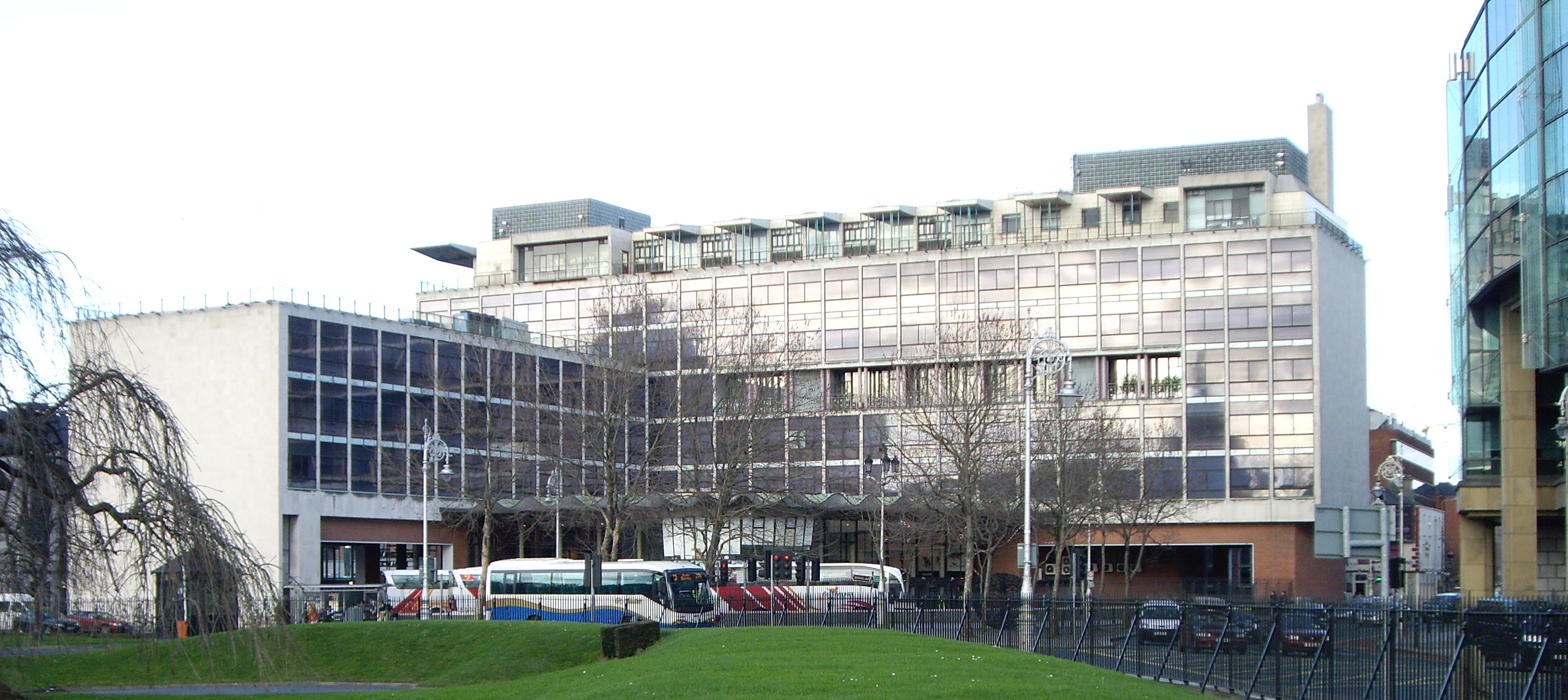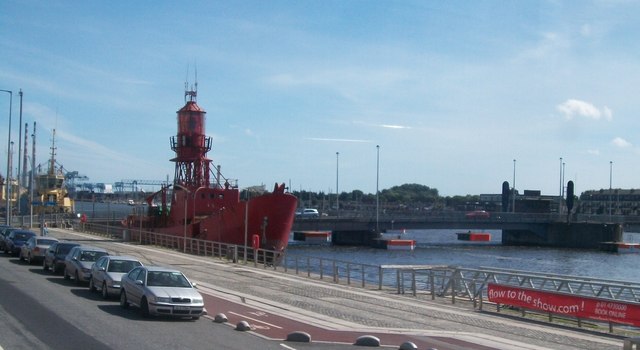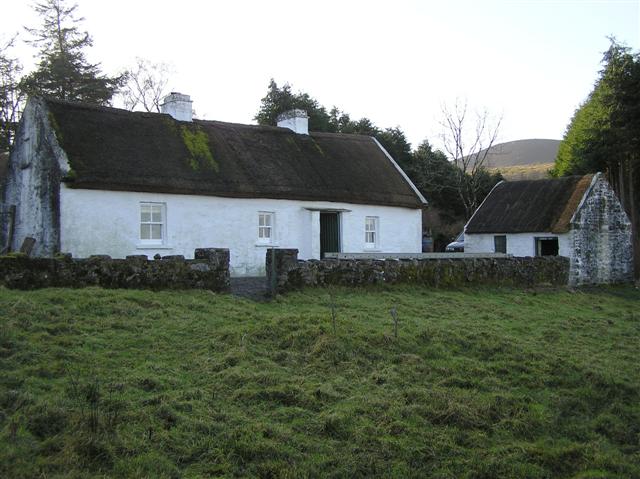|
Busáras
Busáras (; from ''bus'' + '' áras'' "building") is the central bus station in Dublin, Ireland for Intercity and regional bus services operated by Bus Éireann. Designed in the International Modern style, Busáras is also a stop on the Red Line of the Luas system, in Store Street just before the terminus at Dublin Connolly railway station. Áras Mhic Dhiarmada ("Mac Diarmada House") is the official name of the building, which also includes the headquarters of the Department of Social Protection. CIÉ, parent of Bus Éireann, leases the lower floors from the department. Áras Mhic Dhiarmada is named after Seán Mac Diarmada, a leader of the Easter Rising in 1916. History The need for a central bus station in Dublin was identified first by the magazine the ''Irish Builder and Engineer'' in 1937, citing the large volume of passengers waiting for buses out of Dublin along the quays without shelter or other facilities. Four potential locations were identified for the new ... [...More Info...] [...Related Items...] OR: [Wikipedia] [Google] [Baidu] |
Store Street
Store Street ( ga, Sráid an Stórais) is a short street in Dublin, Ireland, running from Amiens Street at right angles to Beresford Place. History The street derived its name from the many store and warehouses that dominated the area due to the proximity to the Custom House Docks complex from the 1790s onwards. It appears as a thoroughfare on maps in 1800. The stores were demolished in the 1940s and the dock near the street to the east of the Custom House, known as the Old Dock (originally Custom House Dock), was filled in. The crescent of houses on Beresford Place, designed by James Gandon, terminate on Store Street. Number 1 in this small crescent, known as Gandon House, also faces onto Store Street. In the late 1800s the prominent English veterinary surgeon, Thomas Drummond Lambert, had a large practice based on Store Street the footprint of which was impacted by the construction of the Loop Line railway bridge by the Dublin, Wicklow and Wexford Railway Company in the ... [...More Info...] [...Related Items...] OR: [Wikipedia] [Google] [Baidu] |
Dublin Connolly Railway Station
Connolly station ( ga, Stáisiún Uí Chonghaile) or Dublin Connolly is one of the busiest railway stations in Dublin and Ireland, and is a focal point in the Irish route network. On the North side of the River Liffey, it provides InterCity, Enterprise and commuter services to the north, north-west, south-east and south-west. The north–south Dublin Area Rapid Transit (DART) and Luas light rail services also pass through the station. The station offices are the headquarters of Irish Rail, Iarnród Éireann. Opened in 1844 as ''Dublin Station'', the ornate facade has a distinctive Italianate tower at its centre. History On 24 May 1844 the Dublin and Drogheda Railway (DDR) began public operations from an interim terminus at the Royal Canal, and on the same day the foundation stone for what is now Connolly station was laid by Earl de Grey, Lord Lieutenant of Ireland. The station was opened for operations on 29 November 1844 as ''Dublin Station'', but was renamed ... [...More Info...] [...Related Items...] OR: [Wikipedia] [Google] [Baidu] |
Michael Scott (architect)
Michael Scott (24 June 1905 – 24 January 1989) was an Irish architect whose buildings included the Busáras building in Dublin, Cork Opera House, the Abbey Theatre and both Tullamore and Portlaoise Hospitals. Early life and education He was born in Drogheda in 1905. His family originated in the Province of Munster. His father, William Scott, was a school inspector from near Sneem on the Iveragh Peninsula in County Kerry. His mother was from County Cork. Michael was educated at Belvedere College, Dublin. There he first demonstrated his skills at painting and acting. Initially, he wanted to pursue a career as a painter but his father pointed out that it might make more financial sense to become an architect. Career Scott became an apprentice for the sum of £375 per annum to the Dublin architectural firm Jones and Kelly. He remained there from 1923 until 1926, where he studied under Alfred E. Jones. In the evenings after work, he also attended the Metropolitan School of ... [...More Info...] [...Related Items...] OR: [Wikipedia] [Google] [Baidu] |
Connolly Station
Connolly station ( ga, Stáisiún Uí Chonghaile) or Dublin Connolly is one of the busiest railway stations in Dublin and Ireland, and is a focal point in the Irish route network. On the North side of the River Liffey, it provides InterCity, Enterprise and commuter services to the north, north-west, south-east and south-west. The north–south Dublin Area Rapid Transit (DART) and Luas light rail services also pass through the station. The station offices are the headquarters of Irish Rail, Iarnród Éireann. Opened in 1844 as ''Dublin Station'', the ornate facade has a distinctive Italianate tower at its centre. History On 24 May 1844 the Dublin and Drogheda Railway (DDR) began public operations from an interim terminus at the Royal Canal, and on the same day the foundation stone for what is now Connolly station was laid by Earl de Grey, Lord Lieutenant of Ireland. The station was opened for operations on 29 November 1844 as ''Dublin Station'', but was renamed ''Am ... [...More Info...] [...Related Items...] OR: [Wikipedia] [Google] [Baidu] |
Luas
Luas (pronounced ; Irish for "speed") is a tram/ light rail system in Dublin, Ireland. There are two main lines: the Green Line, which began operating on 30 June 2004, and the Red Line which opened on 26 September 2004. Since then, both lines have been extended and split into different branches further out of the city. The two lines, as of 2017, now intersect and connect within Dublin city centre. The system now has 67 stations and of revenue track, which in 2018 carried 41.8 million passengers, an increase of 11.2% compared to 2017. Luas is operated by Transdev, under tender from Transport Infrastructure Ireland (TII). (Prior to the later RPA merger with the National Roads Authority to form TII, the tender was originally under the defunct Railway Procurement Agency jurisdiction). The Luas was a major part of the National Transport Authority's strategy (2000–2016). Four extensions to the existing Luas lines have been completed. Construction of a extension to the Gr ... [...More Info...] [...Related Items...] OR: [Wikipedia] [Google] [Baidu] |
Red Line (Luas)
The Red Line () is one of the two lines of Dublin's Luas light rail system. The Red Line runs in an east–west direction through the city centre, north of the River Liffey, before travelling southwest to Tallaght, with a fork to Citywest and Saggart. The Red Line opened on 26 September 2004. History Construction work began in March 2001 on the Tallaght to Connolly line, as well as the Sandyford to St. Stephen's Green section of the second line, with Ansaldo of Italy and MVM of Australia getting the contract to build the system. The St. Stephen's Green to Dublin Airport section was dropped before construction began, as it was decided to serve the area by a metro instead. The contract to maintain operate the system was awarded to Transdev Ireland (formerly known as Connex). The extension from Connolly to The Point opened in 2009, with the extension from Belgard to Saggart opening in 2011. Interchange with the Green Line began in December 2017 with its extension crossing the Red ... [...More Info...] [...Related Items...] OR: [Wikipedia] [Google] [Baidu] |
Seán Mac Diarmada
Seán Mac Diarmada (27 January 1883 – 12 May 1916), also known as Seán MacDermott, was an Irish republican political activist and revolutionary leader. He was one of the seven leaders of the Easter Rising of 1916, which he helped to organise as a member of the Military Committee of the Irish Republican Brotherhood (IRB) and was the second signatory of the Proclamation of the Irish Republic. He was executed for his part in the Rising at age 33. Brought up in rural County Leitrim, he was a member of many associations which promoted the cause of the Irish language, Gaelic revival and Irish nationalism in general, including the Gaelic League and (early in his career) the Irish Catholic fraternity the Ancient Order of Hibernians. He was national organiser for Sinn Féin, and later manager of the newspaper '' Irish Freedom'', started in 1910 by Bulmer Hobson and others. Early life Mac Diarmada was born John MacDermott in Corranmore, close to Kiltyclogher in County L ... [...More Info...] [...Related Items...] OR: [Wikipedia] [Google] [Baidu] |
Bus Éireann
Bus Éireann (; "Irish Bus") is a state-owned bus and coach operator providing services throughout Ireland, with the exception of Dublin and the Greater Dublin Area, where bus services are provided by sister company Dublin Bus. It is a subsidiary of Córas Iompair Éireann (CIÉ). The company's primary hub is '' Busáras, Central Bus Station'', located in Store Street, Central Dublin. History Bus Éireann was established in February 1987 when it was split out from Córas Iompair Éireann (CIÉ). The logo of Bus Éireann incorporates a red Irish Setter, a breed of dog which originated in Ireland. During 2016, it was reported that Bus Éireann amassed losses of around and that these losses were set to rise throughout 2017. As a result, Shane Ross, TD, Ireland's Minister for Transport, Tourism and Sport, mentioned the company "faces insolvency within 18 months". Bus Éireann concluded an all out strike on Thursday 13 April that lasted since Friday 24 March 2017. The ... [...More Info...] [...Related Items...] OR: [Wikipedia] [Google] [Baidu] |
Dublin
Dublin (; , or ) is the capital and largest city of Ireland. On a bay at the mouth of the River Liffey, it is in the province of Leinster, bordered on the south by the Dublin Mountains, a part of the Wicklow Mountains range. At the 2016 census it had a population of 1,173,179, while the preliminary results of the 2022 census recorded that County Dublin as a whole had a population of 1,450,701, and that the population of the Greater Dublin Area was over 2 million, or roughly 40% of the Republic of Ireland's total population. A settlement was established in the area by the Gaels during or before the 7th century, followed by the Vikings. As the Kingdom of Dublin grew, it became Ireland's principal settlement by the 12th century Anglo-Norman invasion of Ireland. The city expanded rapidly from the 17th century and was briefly the second largest in the British Empire and sixth largest in Western Europe after the Acts of Union in 1800. Following independence in 1922, ... [...More Info...] [...Related Items...] OR: [Wikipedia] [Google] [Baidu] |
Dublin Corporation
Dublin Corporation (), known by generations of Dubliners simply as ''The Corpo'', is the former name of the city government and its administrative organisation in Dublin since the 1100s. Significantly re-structured in 1660-1661, even more significantly in 1840, it was modernised on 1 January 2002, as part of a general reform of local government in Ireland, and since then is known as Dublin City Council. This article deals with the history of municipal government in Dublin up to 31 December 2001. The long form of its name was The Lord Mayor, Aldermen and Burgesses of the City of Dublin. History Dublin Corporation was established under the Anglo-Normans in the reign of Henry II of England in the 12th century. Two-chamber Corporation For centuries it was a two-chamber body, made up of an upper house of 24 aldermen, who elected a mayor from their number, and a lower house, known as the "sheriffs and commons", consisting of up to 48 sheriffs peers (former sheriffs) and 96 r ... [...More Info...] [...Related Items...] OR: [Wikipedia] [Google] [Baidu] |
Dublin Quays
The Dublin quays () refers to the two roadways and quays that run along the north and south banks of the River Liffey in Dublin, Ireland. The stretches of the two continuous streets have several different names. However, all but three of the names (Swift's Row, Bachelors Walk and Usher's Island) share the same "Quay" designation. The quays have played an important part in Dublin's history. Much of the southern roadway and about half of the northern roadway is part of the R148 road, while the other half of the northern roadway is part of the R801 road. Routes description Both roadways run approximately 4.3 km (2.7 mi) from Sean Heuston Bridge in the west. The eastern end of the north roadway is at East-Link Bridge while the south roadway turns southward at the Grand Canal. Seventeen bridges cross the river along the line of The Quays; three of them are exclusively pedestrian bridges, one a railway bridge, one other for Luas trams (with another planned) and pe ... [...More Info...] [...Related Items...] OR: [Wikipedia] [Google] [Baidu] |
The Custom House
The Custom House ( ga, Teach an Chustaim) is a neoclassical 18th century building in Dublin, Ireland which houses the Department of Housing, Local Government and Heritage. It is located on the north bank of the River Liffey, on Custom House Quay between Butt Bridge and Talbot Memorial Bridge. History Origins A previous Custom House had been built in 1707 by engineer Thomas Burgh (1670–1730). However, by the late 18th century it was deemed unfit for purpose. The building of a new Custom House for Dublin was the idea of John Beresford, who became first commissioner of revenue for Ireland in 1780. In 1781 he appointed James Gandon as architect, after Thomas Cooley, the original architect on the project, had died. This was Gandon's first large scale commission. The new Custom House was unpopular with the Dublin Corporation and some city merchants who complained that it moved the axis of the city, would leave little room for shipping, and it was being built on what at the tim ... [...More Info...] [...Related Items...] OR: [Wikipedia] [Google] [Baidu] |
.jpg)









